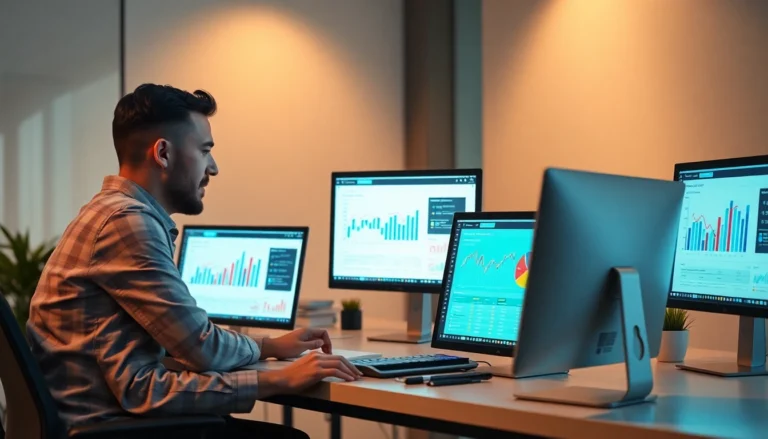Introduction to Trading View and Its Core Features
In the fast-paced world of financial markets, having reliable tools to analyze, visualize, and execute trades is essential for both novice and seasoned traders. One platform that has revolutionized market analysis is trading view. Renowned for its powerful charting capabilities, social trading features, and seamless integration with various markets, Trading View has become a cornerstone in the toolkit of traders worldwide. This comprehensive guide aims to illuminate the platform’s core features, how it enhances trading routines, and strategies to optimize its use for better market insights and decision-making.
What is Trading View and How It Serves Traders
Trading View is a multifaceted financial analysis platform that combines real-time market data, advanced charting tools, social networking, and trading functionalities into a single environment. Originally launched as a web-based platform, it has expanded to mobile applications and desktop versions to accommodate traders’ diverse needs. Its primary goal is to empower traders to allocate market information efficiently, identify trends, and make informed trading decisions.
Unlike traditional charting software, Trading View is distinguished by its user-friendly interface, wide-ranging technical indicators, and collaborative features that foster community engagement. Whether analyzing stocks, cryptocurrencies, forex, commodities, or indices, traders can customize their layouts, develop strategies, and share insights within a vibrant trading community. This interconnected approach not only improves individual performance but also leverages collective market intelligence.
Key Charting Tools and Technical Indicators
At the heart of Trading View are its sophisticated charting tools. Users can access multiple chart types such as candlestick, line, bar, and Renko charts, each offering different perspectives tailored to trading styles. The platform supports multiple timeframes—from seconds to months—allowing for both short-term intraday trading and long-term investment analysis.
Complemented by an extensive library of technical indicators—ranging from moving averages, RSI, MACD, Bollinger Bands, to more complex custom scripts—traders can fine-tune their analysis. The platform’s scripting language, Pine Script, empowers advanced users to create, test, and deploy custom indicators and strategies, fostering innovation and adaptability. The combination of these tools enables traders to recognize chart patterns, measure momentum, and validate trade setups with confidence.
Integrating Trading View into Your Trading Routine
Integrating Trading View into everyday trading involves establishing a workflow that capitalizes on its real-time data and analysis features. Start with customizing watchlists to monitor relevant assets and setting up chart templates that align with your trading strategies. Use alerts for price levels, indicator signals, or pattern formations to automate the detection of key market events. This ensures timely responses without constant manual monitoring.
Moreover, traders should leverage the social aspect by engaging with the community through shared ideas, comments, and collaborative analysis. This interaction can provide additional insights, foster learning, and enhance decision-making in volatile markets. Regularly reviewing past trades and chart patterns within Trading View helps to identify strengths, weaknesses, and areas for improvement, making the platform a central hub for continuous trading education.
Optimizing Your Trading View Setup for Better Market Analysis
Customizing Layouts and Watchlists Effectively
Efficiency in trading is often linked to a well-organized workspace. Trading View allows users to create multiple layout configurations optimized for different markets, timeframes, or trading strategies. For example, a day trader might set up a grid of intraday charts with rapid alerts, while a long-term investor may prefer monthly and weekly views.
In addition, watchlists enable quick access to a curated selection of assets. Customizable watchlist columns can include real-time price, percentage changes, volume, and custom indicators, providing at-a-glance market sentiment. Regularly updating and organizing these lists ensures that traders are focused on relevant opportunities and can swiftly adapt to changing market conditions.
Leveraging Alerts and Notifications for Timely Decisions
Market volatility necessitates prompt action. Trading View’s alert system allows traders to set notifications based on price levels, indicator crossings, pattern detections, or news events. These alerts can be received via email, SMS, or push notifications, enabling traders to stay informed regardless of their location or activity status.
For example, setting an alert for a moving average crossover can signal a potential trend reversal, prompting immediate analysis and execution. Properly calibrated alerts minimize missed opportunities and prevent emotional decision-making, making them indispensable for active traders.
Using Script and Indicator Libraries for Advanced Analysis
Beyond built-in tools, Trading View’s extensive library of scripts and indicators—accessible through the Public Script Library—offers endless customization. Traders can deploy momentum oscillators, volatility indicators, volume models, or develop proprietary algorithms based on their unique strategies.
Advanced users benefit from importing and sharing custom scripts, fostering innovation and collective learning. Combining multiple indicators and scripts allows for multilayered analysis, which enhances signal accuracy and reduces false positives.
Practical Tips for Using Trading View in Live Trading
Creating Trade Triggers and Automated Strategies
Automated trading strategies can be deployed via Trading View’s Pine Script, enabling traders to code and test custom algorithms that execute trades automatically based on predefined criteria. Setting up such scripts reduces reaction time and mitigates emotional biases that can impair decision-making.
Start by defining clear entry and exit conditions, then backtest on historical data to evaluate performance. Successful strategies can be linked with brokers that support the Platform, facilitating semi-automated or fully automated trading workflows.
Collaborating and Sharing Insights with the Trading Community
One of Trading View’s standout features is its social network component. Users can publish their charts and trading ideas publicly or privately, offer feedback, and participate in community discussions. This not only enhances learning but also positions traders as thought leaders within niche markets.
Engaging with the community helps traders validate their analysis, gain new perspectives, and stay motivated through shared successes and challenges.
Managing Multiple Markets and Portfolio Monitoring
Savvy traders monitor multiple markets simultaneously. Trading View’s multi-chart layouts and multi-watchlist features facilitate this effectively. By grouping markets based on asset class or strategy, traders can keep tabs on portfolio performance, identify correlated movements, and reallocate assets proactively.
Real-time data and alerts across multiple markets enable traders to react swiftly to market shifts, ensuring optimal portfolio management and risk mitigation.
Advanced Strategies to Maximize Trading View’s Potential
Implementing Trading Strategies with Backtesting Tools
Backtesting is vital for validating trading strategies before risking real capital. Trading View’s built-in backtesting engine allows traders to simulate historical performance based on their scripts. Analyzing metrics like profitability, drawdowns, and trade frequency offers insights into strategy robustness.
This process helps traders refine their parameters and adapt strategies to changing market dynamics, significantly increasing the likelihood of consistent success.
Utilizing Market Sentiment and Social Data Features
Market sentiment plays a crucial role in decision-making. Trading View integrates social data—such as public ideas, comment streams, and trend analysis—providing a pulse on the collective market mood.
Integrating Trading View with Brokers and Trading Platforms
seamless integration with supported brokers streamlines the trading process. By linking Trading View accounts with compatible brokerage platforms, traders can execute orders directly from charts, view real-time account data, and monitor positions without switching platforms. This integration saves time, reduces errors, and simplifies order management.
Measuring Success and Improving Your Trading Performance
Analyzing Past Trades and Chart Patterns
Consistent review of past trades—identifying successful setups and errors—drives improvement. Trading View’s archives and annotations on charts facilitate detailed analysis of entry points, exit timing, and pattern recognition.
Adjusting Strategies Based on Data and Insights
Data-driven adjustments—such as modifying indicator thresholds, entry rules, or stop-loss levels—are critical for adapting to evolving markets. Use Trading View’s historical analysis to inform such changes, ensuring strategies stay relevant and effective.
Keeping Up with Platform Updates and Market Trends
Staying informed about platform enhancements, new features, and market developments ensures traders maximize Trading View’s evolving capabilities. Regularly exploring updates, participating in webinars, or following official channels sustains a competitive edge in market analysis and execution.

















